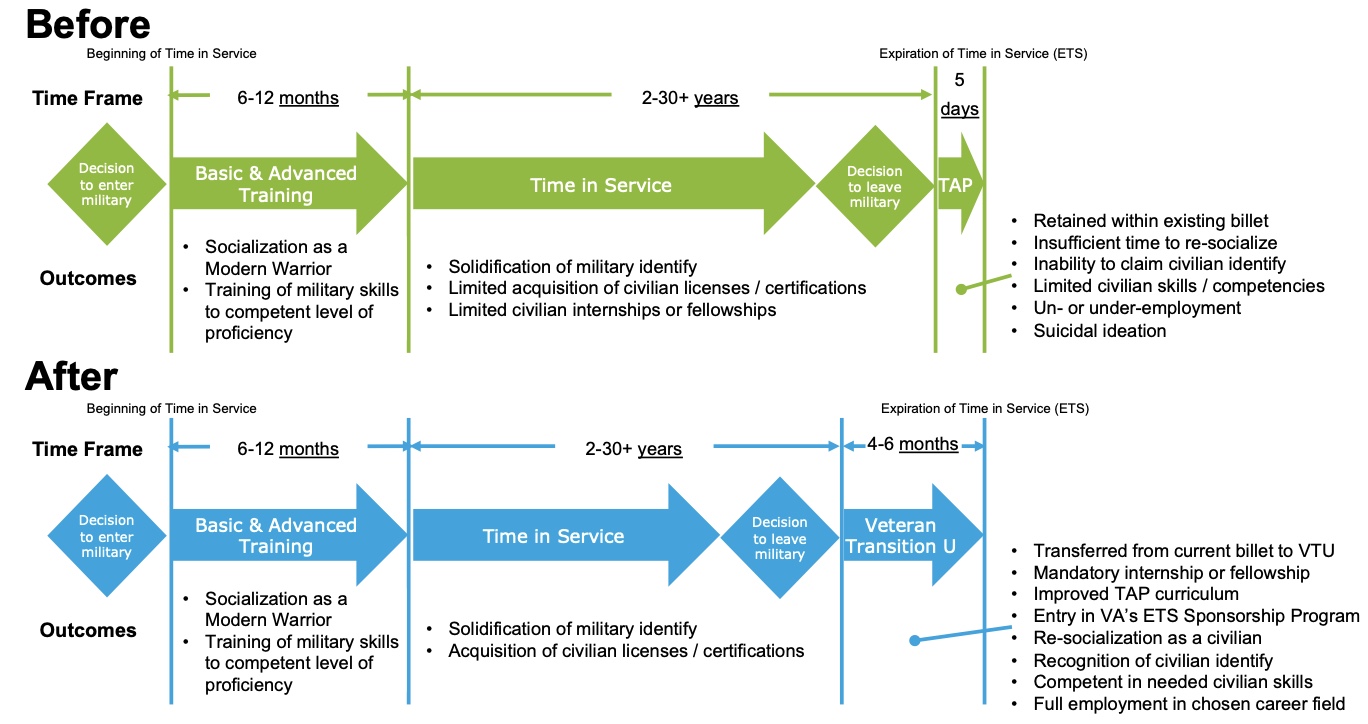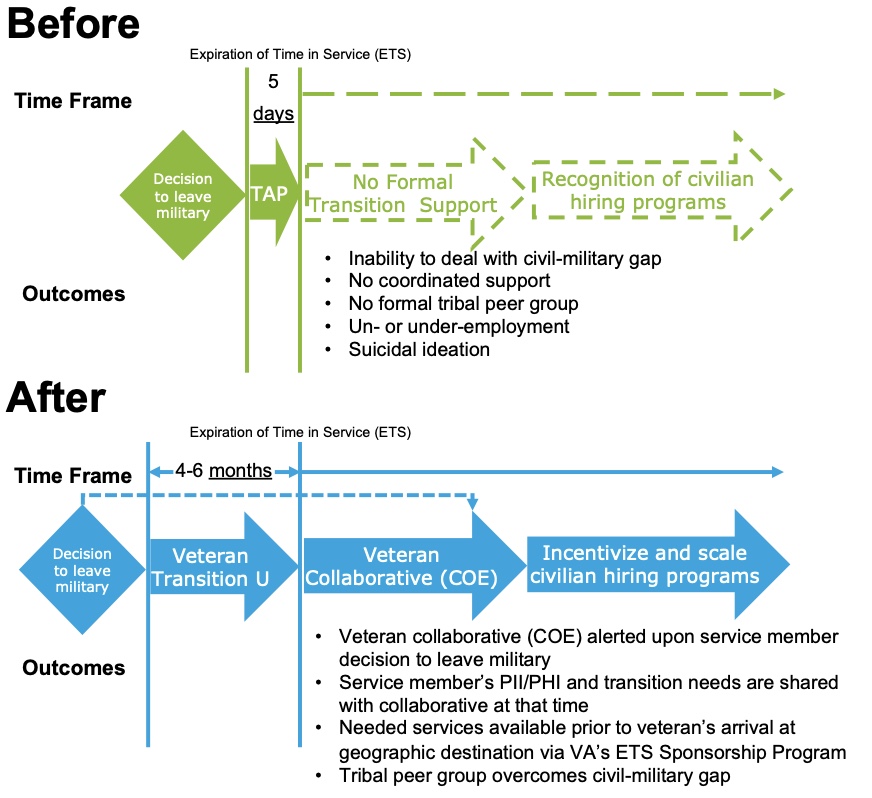Strengthening National Security: How the Military Can Aid Itself and the Nation
Strengthening National Security: How the Military Can Aid Itself and the Nation
The Modern War Institute at West Point recently hosted an essay contest with the prompt: What novel approaches can the United States military employ to solve the recruiting crisis? Below is my response. I welcome your thoughts.
"The willingness with which our young are likely to serve in any war, no matter how justified, shall be directly proportional to how they perceive the veterans of earlier wars were treated and appreciated by their nation."
- George Washington, 1789
Recruiting shortfalls for our nation’s military have reached levels that, according to some, should constitute a national security crisis. The table below indicates projected recruiting shortfalls for the current fiscal year for selected services. This follows the Army’s 25% (15,000) recruiting shortfall last year, which forced it to cut its planned active-duty end strength from 476,000 to 466,000.


Table 1. Projected FY2023 Active-duty Military Recruiting Shortfalls
The implications are rather obvious. Nora Bensahel, visiting professor of Strategic Studies and senior fellow at the Merrill Center at the Johns Hopkins School of Advanced International Studies, noted that in an era of competition among great powers, “the risk is if the US military is too small to conduct the kinds of missions that it needs to conduct in future wars, that that will go badly for the United States.” That may be putting it lightly.
While there are many socio-economic and cultural reasons driving these shortfalls (physical fitness of today’s youth, unfamiliarity with anyone who has previously served, poor academic skills, addiction issues, mental health problems, and criminal records among them), there is one big reason that military leaders control entirely - whether potential recruits view military service as a pathway to successful civilian employment post-service. This is a substantial and persuasive reason in a nation where only 9 percent of young Americans said they would consider military service.
How did we get here?
In many ways, the military itself is to blame. Since its beginning, one constant has been the de-prioritization of supporting service members as they end their time in service. Yes – even in recent decades, as congressional mandates have resulted in mandatory TAP classes and as Skillbridge and other formal internship programs have proliferated. It is not enough.
This lack of support is easy to understand. Leaders in the Pentagon have a limited budget to allocate. Their mission is to fight and win the nation’s wars. Thus, leaders allocate the available budget to efforts and resources that directly enable that mission. Most taxpayers would likely support that thinking. That thinking, however, is short-sighted and overlooks longer-term dynamics at play that have negative consequences for today’s military recruiters.
Why should we support service members leaving the military?
Our leaders in the Pentagon should consider the long-term implications of insufficient support for departing service members. Substantial support to enable a veteran’s full employment in an optimal career field upon Expiration of Time in Service (ETS) directly and substantially impacts the ability to recruit and maintain the nation’s defense successfully.
Although veterans make up only ~8 percent of the nation’s adult population and just over 6 percent of the civilian labor pool, they have an outsized influence over the future of the country’s all-volunteer force that defends our freedom, protects our liberty, and enables capitalism to thrive. If military service does not provide a gateway to successful civilian careers, future recruits may not serve. Why would a prospective recruit enlist after hearing of today’s veterans and departing service members’ challenges in leaving the military? Moreover, the Department of Defense (DoD) must pay Unemployment Insurance for Ex-Servicemembers (UCX) to states whose veterans are not employed. These funds, whose amounts have varied from $200-900+ Million in recent years, subtract from DoD’s operating budget and thereby sacrifice funds that could otherwise be spent on our common defense.
Why focus on employment?
For the individual veteran, full employment in an optimal career field immediately following time in service tends to assuage most other social determinants of health issues. Studies show a positive correlation between an ineffective separation and an increased risk of veteran suicide in the post-9/11 cohort, especially for veterans with less than four years of service and those who experienced less than honorable discharges. In that sense, it is a “silver bullet.” Furthermore, studies show that enabling veterans to find an initial position in their preferred career field upon departing the military will nearly double their earnings, job duration, and retention rate. It is essential to their, their family's, and their community’s post-military success.
For organizations, veterans and military spouses present a monumental talent acquisition opportunity. The Center for a New American Security found that more than 90 percent of HR managers said veterans are promoted faster than their non-veteran peers and 68 percent said that veterans performed better or much better than their non-veteran peers. More than 75 percent also said veterans are easier or significantly easier to manage than their non-veteran peers. Moreover, veterans are among the most valuable components of diversity and inclusion efforts. They emanate from an already diverse talent pool (31% of active-duty service members come from racial and ethnic minority groups), bring many transferable skills, and are readily available. Over 200,000 matriculate from the military annually, representing an ongoing just-in-time talent play. Moreover, their impact is palpable. Cumulative Gallup Workplace Studies uncovered a 22% increase in productivity at organizations that create inclusive environments that include veterans.
In short, ensuring the full employment of our service members in optimal career fields upon ETS is a win-win-win value proposition. Over time and at scale, these approaches positively impact the nation’s economy and position the military as a viable partner in its enablement.
What to do?
As documented in a related white paper, several pre- and post-separation initiatives implemented in parallel hold the promise to enable this desired outcome directly:
Pre-separation solutions
- Implement a Veteran Transition University (VTU) that comprises a service member’s assigned duty station during their last 4-6 months on active duty, during which they are removed from the rolls of their previous command so that the unit can back-fill those vacant positions. Measure the success of TAP and the VTUs by focusing on measurable outcomes rather than operational outputs. Measure the time frame the service member attained a position within their preferred career field. Measure the retention rate of service members in their first role following active duty. Identify trends and their root causes and make corresponding programmatic improvements to address those root causes. The VTU curriculum should include, at a minimum, a much-improved TAP; transitioning veterans, their families, and caregivers; and a mandatory internship or fellowship.
- Supplement TAP with programs that support identity discovery, such as those documented in Mission Transition, the most awarded book of its kind.
- Further involve Veteran Collaboratives, the VA’s ETS Sponsorship program, and other non-governmental actors (i.e., the Veteran Jobs Mission, Purepost) well before separation.
- Better educate the American public on our nation’s veterans’ viability and their valuable role in furthering its institutions. A new book, Hiring Veterans, could play a helpful role.
Post-separation solutions
- Provide additional public-private funding to scale and fully utilize Veteran Collaboratives.
- Establish Veteran Collaboratives as military transition Centers of Excellence (COE).
- Provide a platform and tools for data sharing with Veteran Collaboratives.
- Incentivize and scale formal hiring programs at non-Federal, civilian employers.
Expected Outcomes
Pre-separation solution outcomes


Post-separation solution outcomes


Summary
Rather than viewing civilian organizations as an enemy engaged in a zero-sum war for talent, today’s military leaders should recognize and accept that all military careers inevitably come to an end – and most sooner than later. The more they can do to take a long-term view of efforts to support service members in successfully departing the military and realizing full employment in optimal career fields, the more they will reap recruiting benefits down-board. While the impact of these initiatives will take time to materialize, their collective outcomes will be both systemic and long-lasting.
About the Author
Matt Louis is one of the nation’s leading experts in career transition for members of the military community. He coaches individuals on their transition efforts and advises employers on hiring programs designed to successfully assimilate these valuable talent pools. Matt is also the President of Purepost, the optimal means for matching talent to available roles in the US economy. He is the author of the award-winning[1] and best-selling[2] HarperCollins book Mission Transition, a practical guide for veterans in career transition, their families, and their employers and the award-winning[3] Career Press book Hiring Veterans, a practical guide for organizational leaders on how to build programs to successfully assimilate veterans and military spouses.
[1] 2022 International Readers’ Favorite Gold Medal for Non-Fiction Military; 2021 eLit Book Awards: Gold Medal for Business / Career / Sales, Gold Medal for Current Events (Foreign Affairs / Military), Gold Medal for Best Author Website; 2023 American Book Fest Best Book Award (Legacy Nonfiction), Award Finalist (Legacy: Self-Help / Spirituality); 2023 Independent Author Network Book of the Year Award winner (Outstanding Career/Occupational), Grand Prize (Nonfiction Award, Third Place), Award Finalist (First Nonfiction), Award Finalist (Nonfiction Military/War), Award Finalist (Nonfiction Self-Help/How-To); 2021 Nonfiction Authors Association Silver Book Award; 2022 Global Book Awards (War & Military); 2021 Axiom Business Book Bronze Medal (Career); 2021 Living Now Book Awards Bronze Medal (Motivation / Improvement); 2023 Book Excellence Award (Career); 2023 Book Fest Book Awards: Website / Overall Design, 2nd place; Nonfiction Business - Careers, 3rd place; 2023 Outstanding Creator Awards: Best Non-fiction Book, 2nd place; Best Military Book, 1st place; Best Self-Help & How-to Book, 1st place; Best Educational & Reference Book, 1st place; 2023 International Firebird Book Award (Career & Military Nonfiction); Pinnacle Book Achievement Award (Career) Fall 2022; 2022 Incipere Book Awards (Self-Improvement, 2ndplace); 2022 Chanticleer International Book Awards (Military & Front Line, 1st Place; Instructional & Insightful Nonfiction, Finalist); 2023 Goody Business Book Award Winner (Self-Help / Personal Transformation), Award Finalist (Career Success); 2023 Four Seasons Book Awards Finalist; 2023 BooksShelf Nonfiction Writing Contest Finalist (Top 5%); 5-Star reviews: The Book Commentary, Readers’ Favorite.
[2] #1 for Job Markets & Advice – Amazon, November 2022.
[3] 2023 American Writing Awards Winner (Business Sales), 2023 American Writing Awards Finalist (Business General), 2023 American Writing Awards Finalist (Business Management & Leadership), 2023 American Book Fest Best Book Award Winner (Business Reference), Award Finalist (Business General), Award Finalist (Best New Nonfiction); 2023 Independent Author Network Book of the Year Award Finalist (Military / War); 2023 Goody Business Books Award Winner (Self-Help / How-To), Award Finalist (Leadership / HR & Employee Development); 2023 Global Book Awards Finalist (War & Military); 2023 Pinnacle Book Achievement Award (Business Reference); 5-Star reviews: Readers’ Favorite, The Book Commentary; Amazon #1 New Release (Job Hunting) September 2023.